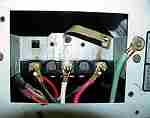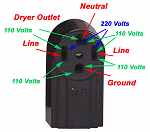John Chisum wrote:
Hello, I am building a new house, the builder has put 3″ PVC VENT PIPE under the cement from landury room to the outside wall, now the inspector tells him that its supposed to be 4″ pipe, what I am asking is will the 3″ PVC VENT PIPE WORK(its installed under the cement floor. Are there any options so this will not have to be removed. and how do i hook up my dryer WHEN ITS A 4″ outlet out of the dryer. Thanks
_______________________________
The above message was sent when you were offline, via your LivePerson site.
Message sent from IP: 208.128.166.15
Holy Guacamole! There are so many things screwed up here I’m not sure where to begin: basic geometry, building codes, re-sale of your house, and plain ol’ common-friggin’-sense. Let’s start with the basics.
Come with me now on a journey back through time, all the way back to when you were just a devilish glint in yo daddy’s eye… Ok, not that far back, but let’s go back to 8th grade geometry class, you know, the one where you were too busy trying to look up Mrs. Soper’s dress to learn how to calculate the area of a circle. Anyway, Mrs. Soper was trying to tell you that to calculate the area of a circle, you multiply the constant PI (3.14) times the square of the radius, like ahso:
A = PI * R^2
Reducing the diameter from 4″ to 3″ (a 25% reduction in diameter, by the way) may not sound like much, but look at the equation for area again. Area varies with the square of the radius. This means little reductions in radius, make for big reductions in cross-sectional flow area. In your case, reducing the diameter from 4″ to 3″ reduces the cross sectional area from about 12.5 sq. in. to about 7 sq. in. So, a measly little 25% reduction in diameter really amounts to a 44% reduction in the cross sectional area. Do you think this will have an effect on your dryer venting efficiency, causing little annoyances like a 44% increase in drying time and a 44% increase in the cost of operating your dryer? Hmmm, there’s a brain tickler for ya. Well, hang with me, Hoss, ‘cuz we gittin’ to the good part.
Check out this table–it lists maximum dryer vent lengths for vents with varying numbers of turns and exhaust fittings for both rigid metal duct and flexible metal duct–all based on a standard 4″ diameter vent. Ok now, let’s take a ezzample. S’pose you have a common, 4″ rigid aluminum dryer vent that idiot builders with half their brains stuffed into Jim Beam bottles install every freakin’ day all across Ameedica. And let’s further suppose that the total length, including all turns, bends, and twists, is 20 feet, that you have three 90 degree elbows, and that the vent terminates in a standard 4″ vent hood. Referring again to the dryer vent length table, you’ll see that the maximum allowable vent length under these conditions is 18 feet–two feet shorter than our hypothetical vent, but probably close enough that the dryer will still work ok.
Now, just for grins, let’s pretend our vent duct is only 3″ diameter instead of 4″, all else remains the same. Ain’t no rocket science here, Hoss: just take the same answer we figgered out above and reduce it by 44%. In other words, where the allowable maximum length for our 4″ vent was 18 feet, if we reduce the vent diameter to 3″, our maximum allowable length is cut down to only 10 feet! With the total vent length at 20 feet, I can guaran-damn-tee you that you’re gonna be running clothes through the dryer at least twice before they get dry, longer as the vent ages and crap builds up in there, which a 3″ vent will do much more quickly. Can I hear a “Shazzayyam!”
Ok, enough higher math. Now tell me this dryer vent wasn’t your idea! If so, then you need to be taken out and thrashed brutally about the thighs and buttocks. What if the concrete settles and fractures part of the duct causing lint to build up at the fault point, you’re going to what…call Mr. Rooter for a ream job? Why not just build an external 4″ vent and then clean or replace every 5 to 10 years or so as needed?
Finally, what happens when you go to sell your house? If I were the home inspector and I saw that–and you better believe I’d look at something like a Jimmy Hoffa dryer vent reeeeal close–I’d tell the prospective buyer, my customer, to stipulate in the contract that the dryer vent be brought up to code. And then, since the house was built by Bozo-with-a-hammer, I’d start wondering what else wasn’t built to code and I’d go fishin’, documenting every little thing just to cover my sweet derriere.
You get my drift, home-boy? Awwite den, go fix that dryer vent.
Recommended Reading: The Ultimate Dryer Venting Guide
























